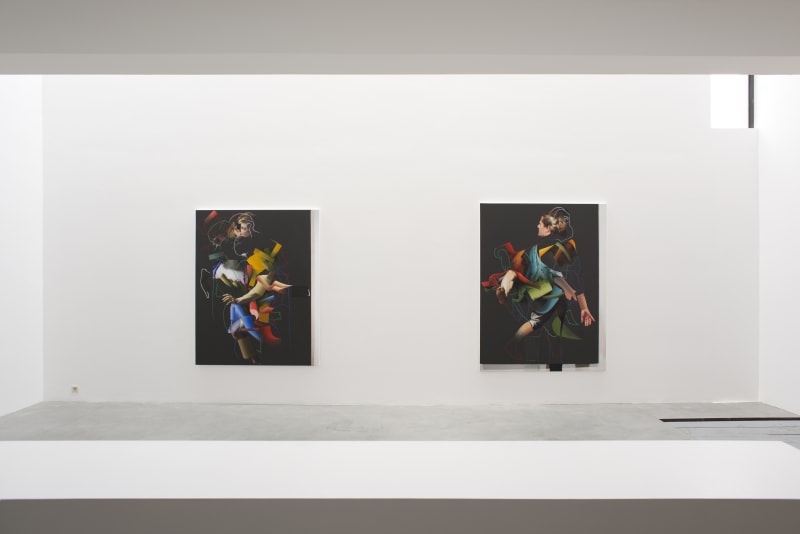Galerie Nathalie Obadia is delighted to present Pieter Schoolwerth’s first Brussels solo exhibition, following Portraits of Paintings in Paris in 2010.
Shadows Past is comprised of recent works that, like those in Schoolwerth’s recent After Troy exhibition at Miguel Abreu Gallery in New York, further the artist’s pictorial research that began with his Z-Axis Cycle and Portraits of Paintings series. Using images sourced from a repertoire of paintings ranging from the Renaissance to the 19th century, Schoolwerth revisits the art of the old masters through a process of methodical and highly original synthesis. Somewhere between abstract ion and figuration, tracing and compression, Schoolwerth’s paintings modify and redeploy visual data from the past in order, as he has stated, “to address the contemporary world.”
The canvases exhibited in After Troy reveal Schoolwerth’s latest developments. For this series, he started with reproductions of two paintings, one by Simon Vouet (1590-1649), the other by Lionello Spada (1576-1622), both depicting the Greek myth of Aeneas. He then digitized, selected, and rearranged elements of the original compositions, blowing them up past their intended print capacity, and output them on canvases measuring more than 180 x 150 cm. Schoolwerth, further, describes the pixelated effect the images gather through this processing as “mechanical pointillism.” In this way, he gives form to a (de)composition, to a new pulverized and dismembered body made up of the superimposed, conglomerated figures from the two paintings under consideration. These fragmented digital figures are interwoven with pastel line drawings in the Renaissance cartoon tradition, and lacerated by abbreviated swaths of paint in a chromatic range aligned with that of the original reproductions.
The artist describes his layered method made up of several rigorous stages of apprehension and elaboration as underscoring “the arc of his desire.” Art critic John Yau emphasizes that within the severe constraints of his painting process, Schoolwerth has ultimately found a way to permit improvisation. He explains that “this is further heightened by the pristine state of the painting’s matte black surface, which suggests that no erasure or major alteration took place during the process, that premier coup painting and drawing into a set of discrete decisions in which revision isn’t allowed.”
An important milestone reached with Shadows Past lies in the series of subtle shifts the painting-object itself makes as it acknowledges its immersion in the digital universe. In one work, for instance, the composition is framed by a trompe l’oeil depiction of a white wall upon which a painting-within-the-painting appears to cast a shadow. A more attentive look reveals that this frame is a pixelized digital picture of the wall upon which the painting hangs while being produced. The destabilizing effect of printing directly on canvas this extraction of the object from its immediate substance adds to the layers of abstraction already at work within the painting: the tracing of the figures; the superimposition of heads and slashing of bodies; the mixing of photography and collage, design and print with gestural abstraction. What results is a kind of new figuration that endeavors, at first, to capture the oblique, yet objective forces of abstraction that act upon and produce the generic body of today, before giving it a new shape and renewed substance through what can still be called painting. A second crucial evolution belonging to this exhibition concerns the emergence of photographed contemporary figure parts within the tumultuous re-articulation of the distant classical works.
The outgrowth of a succession of acts of compression and superimposition, what remains of the memory of the initial depicted bodies – a dismantled mass – floats in space as a single, monstrous formation. In his own words, Schoolwerth practices a kind of “reverse cubism: Picasso or Braque painted a single person from several points of view, whereas I paint several people from a single point of view.”
The contrast between the uniformity of the monochromatic dark ground and the modeled and often bright colored figures is pushed to its limits in this new series. The general effect magnifies the brush strokes, vying with the wild energy of post-war American lyrical abstraction. Like the painters of that generation, Schoolwerth “takes advantage of the resistance of the materials to affirm the tragic dimension of the gesture which comes again and again on the image where ceaseless conflicts are played out." In this unexpected but epoch-appropriate way, this 21th-century New York painter boldly melds the approaches of Caravaggio and Francis Bacon across time, identifying their shared points and transcending their genres.
In parallel with his painting, Pieter Schoolwerth runs the independent record label Wierd Records, and for ten years organized a weekly concert and party at Home Sweet Home on New York’s Lower East Side that featured cold wave, punk and industrial music and DJs. There seems to be a way for Schoolwerth to establish a dialectic between his painting and contemporary music in which he encounters similar issues of ‘superimposition’ and ‘compression.’ He often points out that compression enables him to bring together his two worlds, and that “the brushstroke is the vice that keeps it all together,” the way an MP3 or JPEG file contain and transmit sound and image concurrently.
